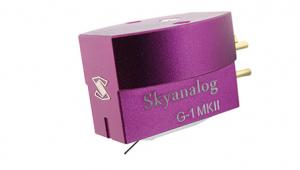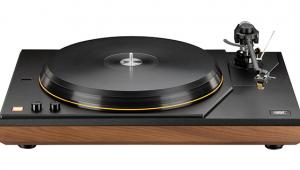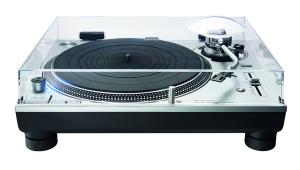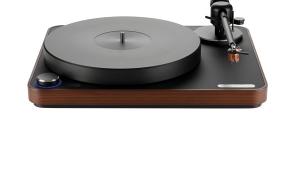Acoustic Signature Barzetti (£1750)
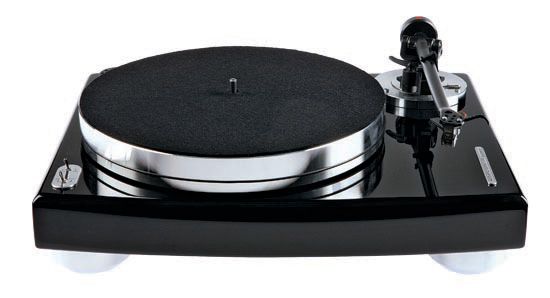
Perhaps, like me, you were brought up and nurtured on the idea that all the best turntables had a suspended subchassis, so that the platter was always bouncing freely on a set of springs. But if you always hated the way a suspended platter wobbles slightly as you put the record on, and the cartridge recoils from your touch, you’ll be receptive to the concept of Gunther Frohnhoefer, Acoustic Signature’s founder and designer.
‘When I was younger,’ he says, ‘I had contact with subchassis players, like the Thorens. And the result you got was always very dependent on how loud you listened to music, and what the turntable was placed on. And if you touch it everything moves. So we said that we’d build everything very rigid, very compact, to make sure that the energy which is hitting the turntable by listening to music cannot have a big effect on the turntable because of its high mass.’
A LIMIT TO THE MASS
Once you’ve decided on the ‘mass’ approach, it might seem that the more mass the better, but, as Gunther puts it, ‘At a certain point, simply adding more mass will not create any improvement, it will only create cost and handling trouble. You can of course build a turntable with a brass platter and things like that, going up to 100kg, but I think this will not really lead to better music reproduction.’
Acoustic Signature’s platters are made of a relatively soft aluminium alloy, always with a coating of damping material on the underside. On the more expensive models, the platter is further damped by brass plugs which the company calls Silencers. Rubber rings top and bottom hold the Silencer in place, so there is no direct contact between brass and aluminium.
Moving up the range, each model uses more Silencers, culminating in the incredible Ascona, a veritable orgy of CNC machining. This has 40 silencers on display around the periphery of its oversized 14in platter, and a further 12 fitted to the big motor flywheel.
However, the main range is now headed by the new floor-standing Thunder, updating the previous Grande Reference. Next comes the Storm, which replaces the rather contradictorily-named Final Tool Mk 2. Apart from other changes, the Storm has a platter studded with eight silencers.
Coming down to earth, and offering a more conventionally domesticated look, is the Manfred, now in Mk 2 form. Here the platter is un-Silencered but still impressively weighty at 6kg, while the plinth is veneered in a choice of wood finishes.
All of which brings us – not before time you may think – to the new Barzetti. Essentially, this very smart new model is a variation on its Manfred theme, but in place of a luxurious but essentially conventional wood-finished plinth, you get a subtly-sculpted item, with an elegant frontal curve reminiscent of Linn’s Majik and Akurate electronics, and an excellent piano-lacquer finish. It’s a finish of such depth and quality, with 10 coats of lacquer said to amount to at least a millimetre in thickness, that you’d hardly guess that the material underneath is MDF.
SELF-LUBRICATING BEARING
Few would argue with Acoustic Signature’s claim that ‘The bearing is the heart of every turntable’. All its models use a special bearing, intended to provide low noise and maintenance-free long life even with very heavy platters. In this design, the bottom end of the shaft rests on a thrust pad made of Tidorfolon, which is a mixture of vanadium, ferrite, Teflon and titanium.
This material has the self-lubricating property of Teflon but is very much harder. For the upper-range models, the shaft is tipped with a tungsten-carbide ball, but for the Barzetti the shaft itself has a radiused and polished end. The shaft runs in a journal made up of two sintered bronze sleeve inserts, and these are again effectively self-lubricating. The granular sintered material is porous, and so it retains the initial lubricant charge.
Drive is provided, via a thin square-section belt, by a low-voltage synchronous motor concealed in the back corner of the plinth, so that only the single drive pulley is visible. Control electronics also built into the plinth utilise the 12V DC provided by an in-line mains power supply unit to synthesise two suitable AC frequencies for 33.3 and 45rpm. Toggle switches for on/off and speed change are mounted together, conveniently near the front edge.Although the arm is Rega’s familiar 251, this is attached to Acoustic Signature’s own grand-looking mounting block, to give easy height adjustment without the need for spacers. The centre part, which carries the arm, can be moved up or down after loosening a single bolt, threaded radially through the outer section.
And that’s it, really. There is no lid or cover, and as supplied the record just sits on a loose felt mat, although the Grip record clamp can be bought as an accessory. Another Acoustic Signature accessory is the neat and effective Tango phono preamp, which fortuitously I still had to hand from a previous review. So I plugged in and started listening.
Since the importer had suggested the Ortofon Vivo Blue MC, it was intriguing to start off by comparing the sound of the Barzetti with this cartridge fitted, and the similarly-equipped Pro-Ject V-Pack [HFN, May ’11]. From the price difference, of course, you’d have a right to expect the Acoustic Signature deck to better the Pro-Ject. As it turned out, the Barzetti quite easily justified its higher cost.
SENSE OF POISE
I kicked off with the Grateful Dead, live in San Francisco in 1980, on the Dead Set double album [Arista DARTY 11]. ‘Samson and Delilah’ immediately had a bigger and wider soundstage than with the Pro-Ject V-Pack, and the sound somehow had a sense of calm solidity and poise that made the Pro-ject sound almost nervy by comparison. With a smoother, slightly less forward midband, if anything it made you more aware of the slightly veiled quality to the vocals on this recording, but at the same time it gave a better-sorted overall picture. Garcia’s guitar had real body, and Brent Mydland’s organ sound was clean and lucid. Bass was relatively light but tuneful.
With Pretenders [RAL 3], Chrissie Hynde’s anthem ‘Precious’ had a great drive to it, her vocal strong, solid and vibrant, out in front, the drums really powerful, those phasey guitar channel-to-channel effects sounding really sweeping and dramatic. Here again the bass at first seemed understated, but actually did have power to it. When it came to the heavier bass sounds and ‘Space Invader’ effects, the Barzetti really did deliver, and everything still sounded rock solid.
For a complete contrast I moved on to Tracy Chapman [Elektra EKT 44] from 1988, and found that the sound on ‘Fast Car’ had a feeling of real solidity and depth. There was a clarity and delicacy to the guitar timbres, while the contrasting deep bass line had just enough weight and wasn’t blemished by boominess or sluggishness. Chapman’s vocals on every track had great presence, giving a sense of instant communication. The Barzetti could also happily bring out the sweetest and delicate sounds, like the hammered dulcimer in ‘Across The Lines.’
On Clapton’s 1978 album Backless [RSO Deluxe RSD 5001], the Barzetti elucidated the music in a way that made for effortless, enjoyable listening. It became cohesive and foot-tapping. You could home in easily on small details: for example, a bit of hand-shaking slide guitar so far back in the mix of ‘Walk Out In The Rain’ that you just registered the rattlesnake clatter of bottleneck on frets, rather than any actual notes. On ‘Watch Out For Lucy’, too, you could get into the swinging beat of the song, with a feeling that the musicians, if not actually in the listening room with you, were at least all playing in the same room together, somewhere behind the speakers.
Moving on to another favourite live album, I put on Bob Marley And The Wailers Live [Island ILPS 9376]. This was really enjoyable on the Barzetti, which yet again seemed to present a big and spacious soundstage with the musicians firmly and convincingly placed. The Barzetti drew you in to the performance well, although with this record I think you get more a sense of wonder that this epic occasion could be captured as well as it was, rather than a real feeling of being there. The Barzetti was certainly up to revealing subtle nuances here, and you could, for example, detect the slight artificiality in the way the applause was mixed in, yet at the same time admire the artfulness with which it was done.
THE TRUTH LAID BARE
Almost the antithesis of live is Arc Of A Diver [Island ILPS 9576], from 1980. Steve Winwood’s virtuosic second solo album is a solo in more than the usual sense, as Winwood plays all the instruments. As the music was created in multiple overdubs by one person, rather than in real time by many, there’s inevitably a kind of constraint about it. The Barzetti conveyed this quite clearly.
It sounded great on Winwood’s soaring synth lines for example, but at the same time seemed able almost to lay bare the way the music had been assembled, and the way it ends up being somehow too neat and tidy for a rock album.
In search of more female vocals, I turned to Stacey Kent’s Dreamsville [Candid CJS9775], as remastered by Pure Pleasure in 2007. Here you could appreciate the singer’s way of using vibrato to make notes that start sounding precise and penetrating, finish up as a kind of purr, cushioned in a lush-sounding production. Again, the Barzetti kept things clean and smooth.
Though it’s a very different, much more raw and intimate kind of recording, Christine Collister’s Love [Rega ENS 002], saw the Barzetti once again demonstrating its seeming ability to allow a vocalist to project, centre-stage, with a full-bodied and yet subtly nuanced sound. Especially on the half-spoken ‘Amelia’, Collister’s fascinatingly resiny vocal tones hung captivatingly between the speakers, while the accompanying instruments kept their distance.
VERDICT
Hitting the right notes visually, the Barzetti has an appealing sound too. The word ‘calm’ kept coming to mind as I tried to describe its presentation, as it has an unhurried, unflappable quality, yet it lets the music come through with zest. It’s relatively impervious to airborne vibration, as the maker claims. Inevitably, you pay a premium to have your turntable built this far West, but this time it’s worth it.
Originally published in the June 2011 issue








